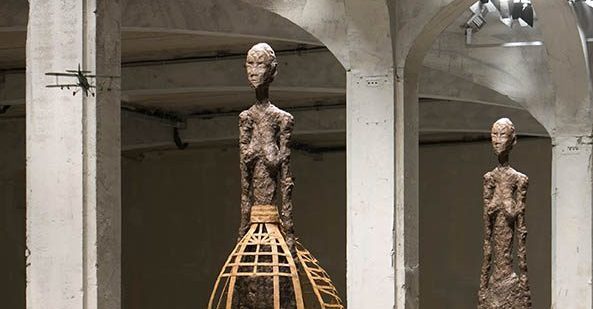In 1935, Alberto Giacometti went back to sculpting from live models after a decade under the spell of Surrealism. His ex-comrades perceived this ‘retrograde’ move as a surrender to representation, and turned their backs on him. Giacometti explained that he was looking not for lifelike renderings but for archetypes of humanity and, after 12 years of struggle, in the mid1940s finally released his signature elongated male and female figures. The largest of them all were the four bronzes (almost 3m high) of the series Grande Femme Debout, commissioned in 1960 for the public plaza of the new Chase Manhattan Bank skyscraper in Lower Manhattan. Talking about them to the critic David Sylvester, Giacometti said: ‘I should be interested to discover the maximum height that I could do by hand. Well, maximum height, that’s precisely what the tall women are. They’re already almost beyond all possibility, and in that case we’re talking about something completely imaginary.’ Imagination, icons and archetypes are such stuff as John Baldessari’s art is made on – like fashion, in fact. So when asked by Fondazione Prada director Germano Celant to think of a project for the cavernous postindustrial, Rem Koolhaas-designed space that alternately hosts the contemporary art exhibitions of the foundation and the glamorous catwalks of the brand, the artist decided to turn the Grandes Femmes into hilarious mannequins in bronze-like resin, and to stretch even further their vertical challenge, up to 4.5m. ‘I’ve always wanted to do tall paintings and sculptures. I suspect it ’s because I ’m quite tall’, he writes in the press notes, with his usual deadpan humour; but also adds: ‘To extend an extreme existing idea to its logical conclusion has been a working method for me’. In the past, Baldessari has summed up his modus operandi with another magic formula: ‘As soon as you put two things together, you get a story’, somehow paraphrasing Breton’s praise, in his Surrealist Manifesto, of ‘certain forms of previously neglected associations’. If nowadays art and fashion are hardly the equivalent of an umbrella and a sewing machine, Baldessari’s version of their chance meeting is nonetheless good fun. Instead of advocating any demarcation, he plays with tautology and borrows directly from the fashion store to make ‘art arise from art’, as he declares. And he makes the most of the occasion to carry on his recent adventures in three-dimensional space, like the giant sculpture Brain/Cloud or the tableau vivant Ear Sofa Nose Sconces with Flowers (in Stage Setting), both from 2009, and presented, respectively, at Tate Modern and Sprüth Magers in London that year.
Cleverly exploiting the bulky row of columns that bisects the Fondazione Prada space, Baldessari echoes the scheme of a defilé by lining up nine ‘top models’. The sculptures are clothed with different garments of his own creation – 18 ‘outfits’ in total, whose sequence and assortment changed twice during the exhibition, as if on a runway – transforming Prada’s ‘temple of style’ into a giant dollhouse. Here comes a Rapunzel with her blonde braids, a bride in white, a Scarlett O’Hara in petticoat and balloon skirt, a cowgirl, a King Kong-esse with tiny aeroplanes around her head, a cerebral Joan of Arc with prêt-à-porter bales of hay for her pyre, a Dorothy and her giant ruby slipper, a matadora in pink and red, a luxury traveller, an Ingrid Bergman-in-Casablanca with a Bogart trench and so on: a condensed catalogue of marketable ‘iconic women’. True to the fashion system, Baldessari provided the idea and some drawings, while couture and manufacture were all ‘made in Italy’. The overall effect is awkward and amusing, kitsch and chic, although the artist denies pursuing parody. ‘My idea’, he candidly states, ‘ is only to comment on our culture’.
John Baldessari, The Giacometti Variations, Fondazione Prada, Milan 29 October – 26 December 2010
From the January & February 2011 issue of ArtReview
